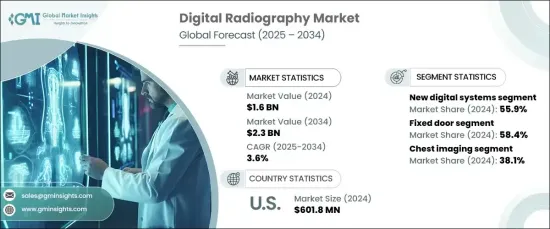
디지털 X선 촬영 세계 시장은 2024년 16억 달러에 달했으며, 2025-2034년간 연평균 3.6%의 안정적인 성장세를 보일 것으로 예상됩니다.
이러한 성장에는 진단 현장에서의 디지털 기술의 급속한 채택, 영상 기술의 지속적인 발전, 의료 시설 내 운영 비용 절감 추진 등 몇 가지 중요한 요인이 기여하고 있습니다. 병원과 진단센터에서는 보다 빠르고 정확한 진단 결과를 제공해야 한다는 압박이 커지면서 디지털 X선 촬영 시스템에 대한 수요가 크게 증가하고 있습니다. 이러한 시스템은 이미지 품질을 개선하고 결과를 도출하는 데 필요한 시간을 단축하기 때문에 빠르게 변화하는 의료 환경에서 필수 불가결한 요소가 되고 있습니다. 또한, 환자 중심의 진료와 간소화된 워크플로우가 점점 더 중요해짐에 따라 의료 서비스 제공업체들은 보다 효율적이고 정확한 진단을 가능하게 하는 디지털 엑스레이 솔루션에 주목하고 있습니다.

전통적인 필름 기반 엑스레이 촬영에서 디지털 시스템으로의 전환은 이 시장의 가장 중요한 성장 촉진요인 중 하나입니다. 의료 서비스 제공업체들은 업무 효율성 개선, 진단 정확도 향상, 기술 주도 산업에서 경쟁력을 유지하기 위해 영상 처리 인프라 현대화에 많은 투자를 하고 있습니다. 이러한 변화는 진화하는 의료 수요에 대응하기 위해 최신 기술을 도입하려는 시설에서 특히 두드러지게 나타나고 있습니다. 이러한 변화의 일환으로 디지털 X선 촬영 시스템은 영상 처리 시간 단축부터 전자 의료 기록(EHR) 및 병원 관리 시스템과의 통합성 향상에 이르기까지 다양한 이점을 제공합니다. 의료의 요구가 계속 진화하는 가운데, 디지털 X선 촬영 시스템은 영상의학의 미래를 주도하는 매우 중요한 역할을 담당할 것으로 보입니다.
| 시장 범위 | |
|---|---|
| 시작 연도 | 2024년 |
| 예측 연도 | 2025-2034년 |
| 시작 금액 | 16억 달러 |
| 예상 금액 | 23억 달러 |
| CAGR | 3.6 |
제품별로는 고정식 디지털 X선 촬영 시스템과 휴대용 디지털 X선 촬영 시스템으로 나뉩니다. 고정식 도어형 시스템은 2024년 58.4%의 높은 점유율을 차지할 것으로 예상됩니다. 이는 대형 병원, 영상 진단센터, 외상 치료실, 환자 수가 많고 빠른 영상 처리가 가능한 외상 치료실에서 널리 사용되는 것이 주요 이유입니다. 또한, 모바일 기기나 핸드헬드 기기 등 휴대용 디지털 X선 촬영 시스템도 다양한 의료 환경에서의 편의성과 범용성으로 지지를 받고 있습니다.
시스템 유형에 따라 시장은 신규 디지털 시스템과 후방 장착형 시스템으로 구분됩니다. 신규 디지털 시스템은 첨단 평면 패널 검출기, 인공지능 기반 영상 처리 도구, 병원 관리 시스템과의 원활한 통합 등 첨단 기술에 힘입어 2024년 시장의 55.9%를 차지할 것으로 예상됩니다. 이러한 첨단 기술을 경쟁력 있는 가격에 이용할 수 있다는 점과 의료기기 제조업체에 대한 보조금 지급이 이 부문의 성장에 기여하고 있습니다.
북미 디지털 X선 촬영 시장은 2024년 6억 1,800만 달러 규모로 성장할 것으로 예상되며, 이는 공공 및 민간 부문의 의료 인프라에 대한 대규모 투자에 힘입은 결과입니다. 영상 진단 기능 강화와 의료 IT 시스템 통합을 위한 조치들이 시장 성장을 견인하고 있습니다. 미국은 잘 구축된 의료 네트워크와 혁신적인 의료기술의 빠른 도입으로 지역 시장 확대의 주요 시장 진출기업로 남아있습니다.
The Global Digital Radiography Market reached USD 1.6 billion in 2024 and is projected to experience a steady growth trajectory, expanding at a CAGR of 3.6% from 2025 to 2034. Several critical factors are contributing to this growth, including the rapid adoption of digital technologies in diagnostic settings, continuous advancements in imaging technologies, and the drive to reduce operational costs within healthcare facilities. With hospitals and diagnostic centers under increasing pressure to provide faster, more accurate diagnostic results, the demand for digital radiography systems has risen significantly. These systems enhance imaging quality and reduce the time needed to produce results, making them indispensable in a fast-paced healthcare environment. Furthermore, with an increasing emphasis on patient-centered care and streamlined workflows, healthcare providers are turning to digital radiography solutions that enable more efficient and precise diagnoses.

The transition from traditional film-based radiography to digital systems represents one of the most significant drivers of growth in this market. Healthcare providers are investing heavily in modernizing their imaging infrastructure to improve operational efficiency, enhance diagnostic accuracy, and stay competitive in an increasingly technology-driven industry. This shift is particularly evident in facilities that seek to embrace the latest technologies to address evolving healthcare demands. As part of this transformation, digital radiography systems offer a wide range of benefits, from faster image processing times to better integration with electronic health records (EHR) and hospital management systems. As healthcare needs continue to evolve, digital radiography will play a pivotal role in driving the future of diagnostic imaging.
| Market Scope | |
|---|---|
| Start Year | 2024 |
| Forecast Year | 2025-2034 |
| Start Value | $1.6 Billion |
| Forecast Value | $2.3 Billion |
| CAGR | 3.6% |
By product, the market is divided into fixed-door and portable digital radiography systems. Fixed-door systems dominate the market, accounting for a substantial share of 58.4% in 2024. This is largely due to their widespread use in large hospitals, imaging centers, and trauma care units, where they handle high patient volumes and enable rapid image processing. Portable digital radiography systems, such as mobile and handheld devices, are also gaining traction for their convenience and versatility in diverse healthcare environments.
In terms of system type, the market is segmented into new digital systems and retrofit systems. New digital systems made up 55.9% of the market in 2024, driven by cutting-edge technologies like advanced flat-panel detectors, artificial intelligence-powered imaging tools, and seamless integration with hospital management systems. The availability of these advanced technologies at competitive prices, coupled with supportive subsidies for medical equipment manufacturers, has contributed to the growth of this segment.
North America digital radiography market generated USD 601.8 million in 2024, fueled by substantial investments in healthcare infrastructure from both the public and private sectors. Policies aimed at enhancing diagnostic imaging capabilities and integrating health IT systems continue to bolster market growth. The United States, with its well-established healthcare network and rapid adoption of innovative medical technologies, remains a key player in regional market expansion.